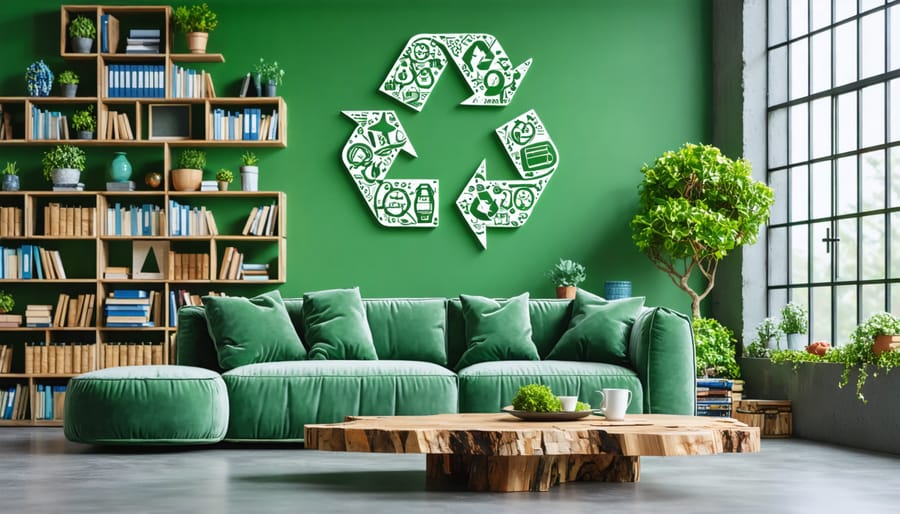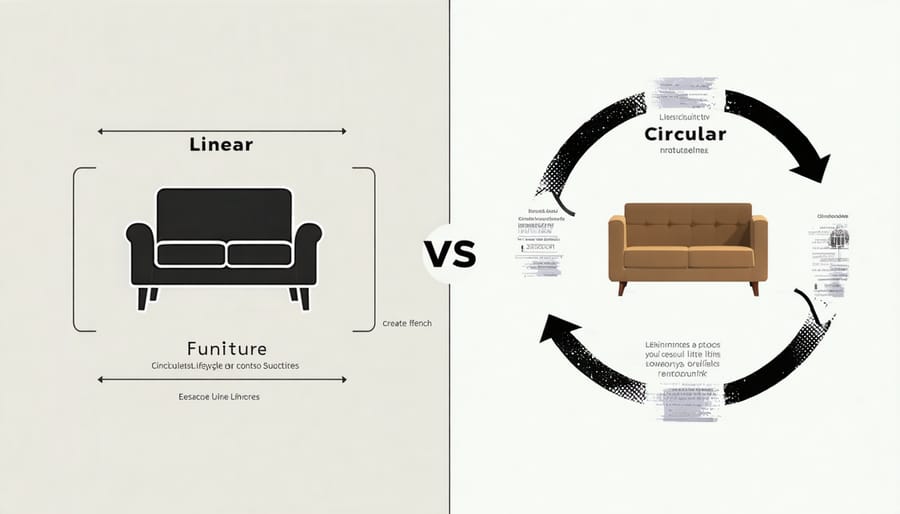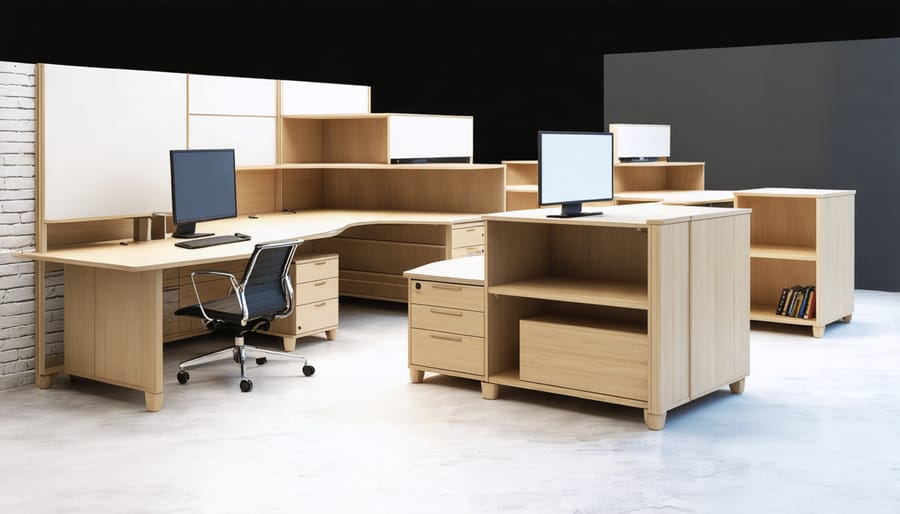
How the Circular Economy is Transforming Modern Furniture (And Your Home)
Imagine a world where nothing goes to waste – that’s the circular economy in action. Unlike our traditional “take-make-dispose” system, the circular economy transforms how we design, produce, and consume everything in our homes, from sofas to storage solutions. It’s a revolutionary approach that keeps furniture and materials in continuous use through reuse, repair, remanufacturing, and recycling.
Think of your home as part of this sustainable loop: that vintage dresser you restored isn’t just a stylish piece – it’s circular economy principles at work. Today’s innovative furniture companies are embracing this model by designing pieces that can be easily disassembled, repaired, and eventually recycled, while using recycled or renewable materials from the start.
This shift isn’t just good for the planet; it’s transforming how we furnish our spaces, create value, and think about ownership. Whether you’re a homeowner looking to make sustainable choices or a designer seeking eco-friendly solutions, understanding the circular economy opens up exciting possibilities for creating beautiful, responsible living spaces.
What Makes Furniture ‘Circular’?
The Three R’s of Circular Furniture
The circular economy in furniture revolves around three fundamental principles: Reduce, Reuse, and Recycle. When shopping for sustainable furniture, these principles guide both manufacturers and consumers toward more environmentally conscious choices.
Reduce focuses on minimizing waste from the start. This means choosing quality pieces that last longer, opting for modular designs that adapt to changing needs, and selecting furniture made with minimal packaging and efficient manufacturing processes.
Reuse encourages extending furniture life through repair, restoration, and reimagining. Whether it’s reupholstering an old chair, converting a dresser into a TV stand, or passing furniture down through generations, reuse keeps perfectly good pieces from ending up in landfills.
Recycle comes into play when furniture truly reaches its end of life. Modern circular furniture design incorporates easily separable materials that can be recycled independently. This might include metal hardware, wood components, or fabric covers that can each be processed differently and given new life in future products.
By following these three R’s, we can significantly reduce furniture waste while creating homes that are both stylish and environmentally responsible.

From Linear to Circular: The Furniture Journey
Traditional furniture production follows a linear “take-make-dispose” model: raw materials are harvested, transformed into furniture, used until worn out, and then discarded in landfills. This wasteful approach has dominated the industry for decades, contributing to deforestation and mounting waste problems.
In contrast, circular furniture production reimagines this entire journey. Materials are carefully selected for durability and recyclability from the start. Pieces are designed to be easily disassembled, repaired, and updated. When a sofa needs reupholstering or a table needs refinishing, these processes are built into the product’s lifecycle rather than being afterthoughts.
Modern circular furniture solutions include modular designs that adapt to changing needs, rental services that ensure continuous use, and take-back programs where manufacturers refurbish and resell used pieces. Many companies now use recycled wood and plastics, while others create furniture from agricultural waste products. Some even offer digital product passports that track materials and guide future recycling efforts.
This shift not only reduces environmental impact but often results in higher-quality, longer-lasting furniture that maintains its value over time.
Circular Design in Modern Furniture
Modular and Adaptable Pieces
Modular furniture represents a cornerstone of the circular economy, offering incredible flexibility and longevity in our living spaces. Think of pieces like sectional sofas that can be rearranged to suit different room layouts, or modular shelving systems that adapt as your storage needs change. These adaptable pieces are designed with transformation in mind, allowing you to reconfigure rather than replace when your needs evolve.
Consider a modular bookshelf system – today it might serve as a room divider in your open-plan living space, but tomorrow it could become a entertainment center or home office storage solution. This adaptability not only saves money but also reduces waste significantly. Many manufacturers now create furniture with interchangeable parts, making it possible to replace only worn components rather than entire pieces.
The beauty of modular design extends to multi-functional furniture as well. Ottoman coffee tables with storage, expandable dining tables, and convertible sofa beds exemplify this approach. These pieces work harder in our spaces, eliminating the need for multiple single-purpose items.
For businesses and commercial spaces, modular office furniture systems offer exceptional flexibility, allowing spaces to be reconfigured as teams grow or shrink. This adaptability ensures that furniture remains useful through multiple office iterations, embodying the circular economy’s principles of maximum resource utilization and minimal waste.

Materials That Close the Loop
The circular economy in furniture relies heavily on sustainable and recyclable materials that can be continuously reused or biodegraded. Bamboo stands out as a rapidly renewable resource that grows quickly and requires minimal processing. Reclaimed wood from old buildings or furniture gives new life to existing materials while preserving their character and reducing waste. Recycled metals, particularly aluminum and steel, can be endlessly reprocessed without losing quality, making them perfect for furniture frames and accessories.
Cork is another excellent circular material, harvested from living trees without harming them, and it’s naturally biodegradable. Bio-based plastics derived from renewable resources like cornstarch offer alternatives to traditional petroleum-based materials. These can be composted or recycled, reducing environmental impact.
Many manufacturers now use recycled fabrics and textiles made from post-consumer waste, such as plastic bottles transformed into durable upholstery materials. Even traditional materials like glass are being reimagined in the circular economy, with recycled glass becoming popular for table tops and decorative elements.
These materials not only support sustainability but often bring unique aesthetic qualities to furniture pieces, proving that eco-friendly choices can be both practical and beautiful.
Making Circular Choices for Your Home
Shopping Tips for Circular Furniture
When shopping for circular furniture, prioritize pieces made from recycled or reclaimed materials, such as restored wood, recycled metals, or repurposed plastics. Look for certification labels like FSC (Forest Stewardship Council) for wood products or Global Recycled Standard for recycled materials. These certifications ensure your furniture aligns with circular economy principles.
Consider modular furniture that can be easily disassembled, repaired, or reconfigured. This adaptability extends the furniture’s lifespan and reduces waste. Check if the manufacturer offers repair services or replacement parts, which is a strong indicator of their commitment to circular principles.
Pay attention to the construction quality and durability. Well-made furniture lasts longer and can be repaired rather than replaced. Ask about the manufacturing process and whether the piece can be easily recycled at the end of its life. Some innovative companies even offer take-back programs where they’ll reclaim and repurpose your old furniture.
Don’t forget to explore second-hand options. Many vintage and antique pieces are built to last and often have unique character. Local marketplaces, estate sales, and refurbishment shops are excellent sources for quality pre-loved furniture that keeps materials in use and supports the circular economy.
Extending Furniture Life Through DIY
Extending the life of your furniture isn’t just good for your wallet – it’s a key practice in the circular economy. Simple maintenance routines can dramatically increase furniture longevity. Start by regularly dusting and cleaning your pieces with appropriate products, checking for loose screws or joints monthly, and addressing any damage promptly before it worsens.
When furniture shows signs of wear, consider restoration instead of replacement. Basic tools like wood filler, sandpaper, and paint can transform tired pieces into stunning statement items. For wooden furniture, periodic refinishing can prevent deterioration and maintain structural integrity. Learn essential upcycling tips to breathe new life into old pieces – from reupholstering chairs to converting old dressers into modern storage solutions.
Smart storage and handling also play crucial roles. Keep furniture away from direct sunlight, maintain consistent room temperature and humidity levels, and use appropriate cleaning products. For upholstered pieces, regular vacuum cleaning and prompt stain treatment can prevent permanent damage. These simple practices not only extend furniture life but also reduce waste and support sustainable living principles, making your home a perfect example of circular economy in action.

The Future of Circular Furniture
The furniture industry is undergoing a remarkable transformation, embracing innovative technologies and design approaches that prioritize sustainability and circularity. Smart furniture with modular components is gaining popularity, allowing pieces to be easily disassembled, repaired, or upgraded rather than discarded. This adaptive approach extends furniture lifespan while reducing waste.
3D printing technology is revolutionizing furniture production, enabling manufacturers to create pieces using recycled materials and produce replacement parts on demand. This eliminates the need for large inventories and reduces transportation emissions. Additionally, furniture subscription services are emerging, offering consumers flexible access to high-quality pieces without the commitment of ownership.
Biomaterials are making waves in circular furniture design, with companies developing sustainable alternatives to traditional materials. Mushroom-based composites, recycled ocean plastics, and agricultural waste are being transformed into durable furniture components. These innovations not only reduce environmental impact but often create stronger, more resilient products.
Digital platforms are connecting consumers with local craftspeople for furniture repair and customization, while blockchain technology is being used to track furniture materials and verify sustainability claims. As artificial intelligence advances, we’re seeing smart design tools that optimize furniture for disassembly and recycling from the concept stage.
The future of circular furniture isn’t just about sustainability – it’s about creating adaptable, technology-enabled pieces that evolve with our changing needs while maintaining environmental responsibility.
The circular economy represents a transformative approach to how we think about and use resources in our homes and businesses. By embracing principles like reduce, reuse, and recycle, we can all contribute to a more sustainable future. Whether you’re a homeowner looking to minimize waste, a designer seeking eco-friendly solutions, or a property manager aiming to implement sustainable practices, the circular economy offers practical solutions for everyone. Start small by repairing furniture instead of replacing it, choosing products made from recycled materials, or participating in furniture exchange programs. Remember, every step toward circular living, no matter how small, helps create a more sustainable world for future generations. Take action today by evaluating your current practices and identifying areas where you can incorporate circular economy principles into your space.
